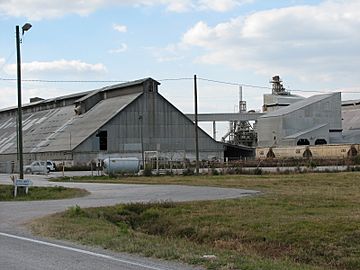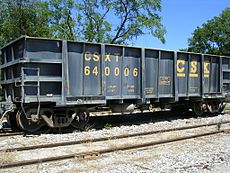Bone Valley facts for kids

The Bone Valley is a special area in central Florida. It includes parts of Hardee, Hillsborough, Manatee, and Polk counties. This region is famous for its large amounts of phosphate. Phosphate is a mineral dug up from the ground. It is mainly used to make fertilizer for farms. Florida has the biggest known phosphate deposits in the United States.
Contents
How is Phosphate Mined and Processed?
Digging Up the Phosphate

Huge machines called draglines work all day and night in open mines. They dig up a mix of phosphate, clay, and sand. This mix is called "matrix." The matrix has some natural impurities, like a tiny bit of uranium. Because of this, a leftover material called phosphogypsum is slightly radioactive. This means it cannot be used in most places.
Turning Phosphate into Fertilizer
First, the matrix is dropped into a pit. It is mixed with water to make a thick liquid called a slurry. This slurry is then pumped through long pipes to washing plants. These plants clean the phosphate. They crush, sift, and separate the phosphate from the sand and clay. More water is added to create a granular rock called "wetrock."
The wetrock is usually moved by train to fertilizer plants. Here, it is processed into useful products. These products include different types of phosphate fertilizers. Some common ones are diammonium phosphate (DAP) and monoammonium phosphate (MAP).
What Happens to Waste?
After processing, there are waste materials left over. These are stored in large piles called phosphogypsum stacks. They are also kept in settling ponds. These ponds can be very big, sometimes hundreds of acres wide and very tall.
Making phosphate also creates fluorine gas. This gas must be cleaned using special filters called scrubbers.
Shipping the Final Product
Much of the final phosphate product, known as 'dryrock,' is sent by train to places along Tampa Bay. From there, it is loaded onto ships. These ships carry the phosphate to other countries, like China. Phosphate used in the United States is loaded onto special unit trains of covered hopper cars. These trains then travel north.
The History of Phosphate Mining in Florida
Early Discoveries
In 1881, Captain Francis LeBaron of the United States Army Corps of Engineers made an important discovery. He was exploring the lower Peace River area. He found many prehistoric fossils in the sandbars of the Peace River. He also noticed that these fossils and the ground they were in had a valuable phosphate quality. The Smithsonian Institution wanted him to find more fossils. But Captain LeBaron had other important duties.
In December 1886, LeBaron returned to the Peace River. He dug some test pits and sent samples to a lab. The tests showed high-quality phosphate. LeBaron tried to get investors interested, but no one would put money into the project.
The Start of Mining
The test results became known to Colonel G.W. Scott. He owned a manufacturing company in Atlanta. He sent someone to Arcadia, Florida, who bought large areas of land along the Peace River. Colonel T.S. Moorhead also learned about the phosphate. He found the sandbars and started the Arcadia Phosphate Company. The first shipment of Florida phosphate was in May 1888. Ten train car loads were sent to Scott's Fertilizer Works in Atlanta.
Soon after, the Peace River Phosphate Company was formed in January 1887. It was located in Arcadia. This company built a narrow gauge railroad from their works to connect with the Florida Southern Railway. They began mining in the winter of 1889. Most of the phosphate was sent to Punta Gorda by train. From there, it was loaded onto ships and sent to Europe.
How Mining Changed
At first, mining was done by hand with picks and shovels. Workers dug up the sandbars above the water. The material was carried on barges to nearby drying plants. Soon, special dredge machines were used. Mining then spread along the lower Peace River.
Over time, different phosphate companies merged. In December 1894, Joseph Hull combined several companies into the Peace River Phosphate Mining Company. This company became a big player in the phosphate industry.
Later, in 1899, the American Agricultural Chemical Co. (AACC) was formed. It bought shares of the Peace River Phosphate Mining Co. The Peace River Phosphate Mining Company Railroad had a main line and several short branches. These connected to other railroads and drying plants.
In the early years, phosphate was shipped from the Peace River area to Punta Gorda or Port Tampa. Other important ports were later built at Seddon Island, Boca Grande, and Rockport.
Today, Mosaic Inc. is the main company mining in the Bone Valley. They are looking to mine in areas further south, in Hardee and Manatee Counties. The demand for fertilizer is expected to grow, especially with the use of corn for ethanol fuel.
Train Services for Phosphate
For most of the 1900s, two major railroads served the Bone Valley. These were the Atlantic Coast Line and the Seaboard Air Line. Many phosphate plants and mines used both railroads. In 1967, these two companies merged to form the Seaboard Coast Line. This company later became part of CSX Transportation.
What are the Risks of Phosphate Mining?

Phosphate mining in Florida mostly happens in the Peace River watershed. Mining companies use large draglines to remove soil up to 60 feet deep. This happens over thousands of acres. After mining, state law requires the land to be restored. Wetlands are rebuilt to be similar to what was there before. In fact, many modern mining permits require companies to create even more wetlands than were originally on the land. Over 180,000 acres have already been mined and restored in the Peace River watershed.
Concerns About Clay Waste
One byproduct of mining is clay. This clay is stored in settling ponds. These ponds can cover thousands of acres and make up a large part of a mine site. Rain drains slower through these clay ponds than through normal soil. Some people worry this might reduce the natural flow of water into the Peace River. However, some studies suggest that restored lands can provide a more steady water flow. This is because the sandier soil in restored areas allows water to flow faster, while the clay provides a slower, steady flow. This can mean more water during dry times.
Water Quality and Spills
Each holding pond is seen as a risk to water quality, public health, and wildlife. Sometimes, the dams holding these ponds have overflowed or broken. This sends a mix of clay into the river. This clay can cover the riverbed for many miles. It can harm plants and animals in the river.
In 1971, a big spill happened. Over two million gallons of phosphate waste went into the river. This killed more than three million fish. Since that spill, clay settling areas are now built with stronger, engineered dams.
In 2004, during Hurricane Frances, a phosphogypsum stack was flooded by heavy rains. The walls broke, sending over 18,000 gallons of acidic water into Tampa Bay. The company that owned the stack added lime to the water to make it less acidic. Because of the huge amount of rain, the spill was quickly diluted. The environmental damage was small. The company also greatly improved its water treatment system.
Sometimes, clay spills have stopped the Peace River Manasota Water Supply Authority from using river water for drinking. This forces towns to find water from other places. Heavy rains have also caused sinkholes to open up under the settling ponds.
In August 2016, a sinkhole formed under a gypsum stack at a Mosaic plant in Mulberry, Florida. This caused 215 million gallons of water to leak into the Floridan Aquifer, which is a major source of groundwater.
More recently, in March 2021, millions of gallons of wastewater from a former plant in Manatee County were released into Tampa Bay. This was done to prevent a bigger failure at the plant. Environmental groups are worried about how this nutrient-rich water will affect wildlife in Tampa Bay. They also worry about potential red tide blooms, which can harm the economy.

